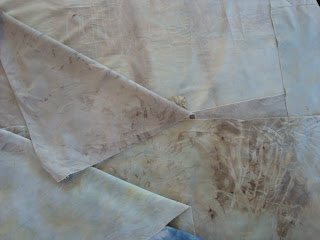Bark Soup left me feeling tired, run-down, listless. Well, not really, but I can't resist the Geritol references since I'm talking about iron and dye(it). Hmm. Now I'm wondering if I could print fabric with Geritol.
Anyway. My mom spent years trying to keep sheets and underwear from turning orange in the wash when we were on the farm, where the high iron content in our well water was pretty high. I seem to remember, too, a crisis caused by wet fabric left in the washer, where a chip in the enamel on the tub left a very permanent orange stain. We won't be telling Mom I do this on purpose now.
One of the easiest ways to do mineral printing is to dampen fabric, wrap it around something that a) is rusty or b) will rust, and keep it from drying out while the color develops. That's why the piece above is inserted in a plastic bag -- to keep it from drying out. You can't see in the picture, but the bag is not sealed. You want this to oxidize.
The photo above shows what that sample looked like after being left overnight and unwrapped the next day. The color on this piece was produced by rusty sheet metal and the chain I used to hold fabric bundles down in the simmering bark soup. The fabric is a cotton percale pillowcase from the thrift shop. My favorite part of this piece was the seam at the border.
The liquid you use to dampen the fabric can be plain water (takes longer), a mixture of vinegar and water (faster), plain vinegar (faster yet), or what I call Tannin Juice.
Tannin Juice is basically vinegar on steroids. In summer, I stuff fresh willow leaves or fresh staghorn sumac leaves into jugs of vinegar. That's it. Put a cap on it, let it sit in a dark corner, and pull it out when you want a really fast, strong reaction. As always, you'll want to sample this. Because the results may be unexpected.
I did a little experiment with Tannin Juice to test how I might use it for resist printing. The fabric here is some of the cotton that was soaked overnight in an iron kettle with elm bark then simmered in bark soup with an iron chain. You may not see any rusty orange on it, but this fabric is not only tannin-infused but also mineral-infused. I laid string I had used to tie up bundles on the fabric, then brushed over it all with Tannin Juice. This isn't as black as I've gotten on other pieces (mostly silk), but it is pretty dramatic. I don't like the hard lines I got from brushing on the tannin juice. Next time I'll put the juice in a spray bottle.
I did another little experiment to sample how I might use the pickled sumac leaves from the Tannin Juice.
I laid the leaves on another piece of fabric from the bark soup collection, pulling them out of the jug with a pair of long forceps.
I wadded the fabric around the leaves, then poured on a bit of iron liquor, which I make by dissolving metal (steel wool works well) in vinegar.
The orange is from the iron liquor. The black is from the pickled sumac leaves.
I promised last time to show some of the Bark Soup fabric overdyed in the indigo vat. The vat is due for some attention, but two dips gave me a soft shift in the color that I really like.
I was thinking I would use this fabric in a wall piece, but now I'm wondering if I have enough to make another Crossover Top from the Kayla Kennington pattern.
It will have to wait a bit, though.I'm chained to the computer for a few more days until I complete another project. In the evenings I've been looping motifs for my freeform vest and making looped heart pins for Valentine's Day.
Would you like a short tutorial on the hearts? Let me know in the comments.










No comments:
Post a Comment
This blog has moved to http://donnakallnerfiberart.com. I hope you'll join the conversation there!